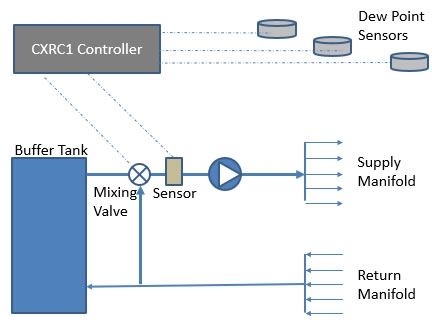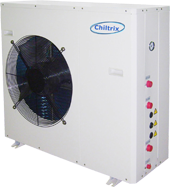Radiant Cooling ControllerUse a Radiant Heating System For Cooling |
 |
The CXRC1 radiant cooling controller continuously monitors up to (8) eight indoor dew point sensors and accurately modulates the water temperature feeding the radiant system to keep it close to, but above, the dew point. This prevents the problem of condensation forming on a radiant floor or radiant panel surfaces. |
|||||||||
Note - the CXRC1 is not a radiant controller. Rather, it is a radiant cooling controller add-on that can be added to and work with a standard radiant heating controller. It simply provides the additional functionality needed to perform radiant cooling without the problems of condensation. Sometimes called a Radiant Dew Point Controller, the CXRC1 includes the following system components:
|
|||||||||
|
|
||||||||
Advantages of the CXRC1 Radiant Dew Point ControllerThe CXRC1 is a stand-alone radiant dew point controller that can work with nearly all radiant heating controllers. No need for a new radiant control system, just add the CXRC1. Works with Chiltrix or with any chilled water source to allow radiant cooling without condensation problems. Advantages, Disadvantages, Tips for Radiant Cooling In General:
Radiant cooling is not an ideal primary cooling option for humid climates, but even in a humid climate it can be used to augment a forced air cooling system that is short on capacity, or to save money by performing a large percentage of the cooling as a higher efficiency. In wet climates, radiant cooling can be used along with fan coils or other cooling equipment, or with a dehumidifier, to carry part of the load, dramatically increasing the EER of the overall system. Radiant cooling requires the addition of a special radiant cooling controller which modulates the temperature of the water entering the radiant system, to keep the radiant surface above the dew point, thus preventing unwanted condensation. Indoor air quality is vastly superior with radiant cooling, compared to forced air cooling. That's because dust, mites, and pollen no longer drift continuously on air and instead are allowed to fall to the floor by gravity where they are removed with the vacuum cleaner or other floor cleaning. Have a room with a lot of south facing window glass? This makes the floor in that room a magnet (an absorber) for summer time radiant heating which then heats the room up as it emits the radiant energy it has absorbed. Such a room may "feel" hot even when the thermostat is satisfied. Radiant cooling in the floor of that room can eliminate or sharply mitigate such a problem, even in a humid climate. Radiant cooling allows customers who already have radiant heating a fairly simple way to add cooling to their home with minimal additional hardware and labor cost without adding fan coil units, air handlers, ductwork, etc. Radiant cooling (and heating) help you gain extra comfort and efficiency in homes with high air changes, such as when using outside air ventilation (or, simply a leaky home). Due to the nature of radiant cooling & heating, a vast amount of outdoor air can be brought in while maintaining comfortable indoor temperatures. Radiant cooling and heating both work well from the ceiling, in fact both radiant heating and cooling can work better from the ceiling. This may go against 100 years of radiant "floor heating" folklore but as a matter of physics it's clear that the ceiling works as well if not better. Radiant heating and cooling are the result of transmission and absorption/emittance of light (photons) at a wavelength called LWIR (long wave infra red) that cannot be seen by the human eye. But it is still light. With that said, would you light a room from the floor? If you have radiant in the floor, that's fine and a proven method. For new construction, consider radiant from the ceiling. Radiant cooling may require a dehumidifier at times of high humidity. A dehumidifier removes humidity as needed to protect against EMC, mold, corrosion, and to make the home more comfortable - this process also lowers the dew point, allowing a radiant cooling system to operate at a lower temperature thus having more cooling capacity. While a dehumidifier may not need to operate frequently, in many climates it is desirable to have a dehumidifier since for example, rainy weather can cause a spike humidity. In general, a small dehumidifier somewhat centrally located is all that's needed. Here are some interesting articles on radiant heating & cooling: See Radiant Cooling White Paper See CXRC1 Radiant Cooling Controller Manual See CXRC1 Radiant Cooling Controller Specification Sheet See Dew Point Relative Humidity Chart For Radiant Calculators Click Here Radiant Heating Hardwood Floor ProtectionAn added bonus feature of CXRC, it can limit the maximum heating temperature during the heating season. So if you want to use radiant heating with an engineered, laminated, or hardwood floor - and are required to limit the maximum temperature to protect the floor and/or the floor warranty - the CXRC can handle this for you. See the v1.2 CXRC manual. |
|
|---|---|
 |
The CXRC1 radiant cooling controller monitors up to 8 dew point sensors and one water temperature sensor. Most customers will only need 1-3 sensors. The controller continually adjusts the mixing valve to make sure that the water entering the radiant supply manifold remains above the user adjustable dew point target. The dew point target has adjustable hysteresis to account for any R-value that may exist between the radiant tubing and the room, it can be set at a point between Dew Point +10 and Dew Point -10. Default suggested is Dew Point +1. |
|
NEW FEATURE:
|
| Click to Watch ABC News Video (2:35) |
World's Record Efficiency The Worlds Most Efficient Air-To-Water Heat Pump |
EPA/ Energy Star |
|
|
 |
About the CXRC1 dew point controller for radiant cooling - we never expected we would build such a product. Our focus has always been on the "supply side" and with some tanks, ductless, and ducted fan coil units. We always considered the actual radiant side to be a highly specialized skill set best left to the experts, and we still feel that way.
However, the radiant industry has not moved very fast with understanding the physics of radiant cooling technology and customers who could benefit from radiant cooling are often left without many good options.
Existing options from Tekmar are costly, and cumbersome, and are not ideal for a "smart" heat pump like Chiltrix. And any other options are very expensive and require the customer to completely replace their existing radiant controller in order to upgrade to cooling.
Chiltrix decided to fill that gap and develop a very simple and low cost radiant cooling "add-on" controller that can add radiant cooling dew point control functionality to any standard radiant heating controller. All that needs to be replaced are any thermostats that don't have a cooling function.